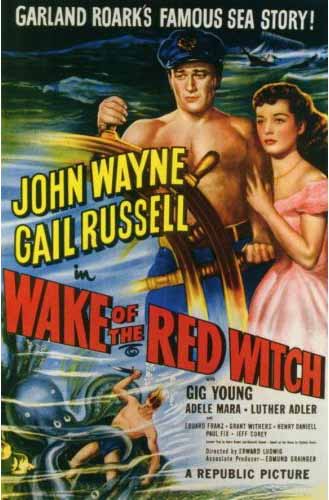
In the first chapter of this dissertation, I noted that Turner Classic Movies one fair evening featured a slate of killer octopus movies. The first was It Came From Beneath the Sea. The second was 1948’s Wake of the Red Witch. This was rather more in the ballpark of what I was interested in, in that the film didn’t revolve around a killer octopus, but instead featured one in a big scene. (Sort of like, albeit not as impressively, Walt Disney’s 20,000 Leagues Beneath the Sea featured that giant squid.) It also pretty much answers the age-old question, “Who is the biggest movie star ever to fight a killer rubber octopus in a film?”
The actor in question in this particular case was John Wayne. This pretty much ends the debate by default, as Wayne is arguably the single biggest movie star to start with. And even if one wishes to argue that proposition, well…Jimmy Stewart never fought a movie octopus. Nor did Henry Fonda or Marilyn Monroe or Humphrey Bogart or Cary Grant. So there you go.
Our tale starts in 1860. Wayne is Ralls, the two-fisted, quite patently Wolf Larson-like captain of the merchant ship The Red Witch.* Life aboard the Witch is immediately established as harsh and brutish—not exactly an unrealistic portrayal of maritime life at the time—when we see Ralls aloofly stand by and watch as two of his crew savagely batter away at one another.
[*The ship is identified as being part of the “Batjak” line. Wayne later adopted Batjac as the name of his personal production company, so needless to say I giggled like the film nerd I am when I heard the word used here. The spelling discrepancy occurred because when Wayne’s secretary typed the original paperwork, she misspelled the word. Wayne left it that way.]Veteran seaman Sam Rosen (Gig Young) has just recently joined the crew, and watches the brawl and the crew’s acceptance of it warily. Even so, he quickly becomes of Ralls’ trusted cronies. He is at that point somewhat shocked, although not enough to break with Ralls, to learn that the latter plans to sink lose his ship, which is carrying a fortune in gold. Ralls will bum around a couple of years, and then dive down and reclaim the gold.
The first part of this scheme is affected. Ralls arranges for the ship to leave its scheduled route. This brings to his cabin the suspicious and hostile Batjac representative Mr. Loring (the always welcome Jeff Corey). It’s here we learn that Ralls is prey to psychotic blackouts. Falling into a sweaty fugue, he administers a savage beating unto Loring, one that leaves his own fists covered with blood. When Rosen enters the cabin and sees the necessarily off-camera result, he blanches. Today we’d get a gory effects shot in lieu of such reticence. Frankly, I’m not sure it isn’t more carry more impact the way they shot it.
In any case, Ralls succeeds, and the Red Witch goes down in a location only he really knows. At this point we meet Mayrant Ruysdaal Sidneye,* owner of Batjac and Ralls’ would-be nemesis. An icy toad of a man in a wheelchair, the gradually revealed explanation for his obsessive hatred for Ralls occupies much of the remaining narrative. Indeed, Mayrant’s preoccupation with Ralls is so intense that it seems outright sexual—he hates Ralls with all his being, and yet tellingly finds all other men feeble in comparison—and I’m not one who discerns homosexual subtext in every old movie I see.
[*The film is filled with (to American ears) bizarre character names, mostly either native or Dutch: Teleia Van Schreeven, Harmenszoon Van Schreeven, Mayrant Ruysdaal Sidneye, Ua Nuke, etc.]Ralls ends up on the South Pacific island where Mayrant makes his home. To Ralls further disgruntlement, the natives who live there consider Ralls an actual demigod, given events that occurred when he last visited them. Against this backdrop, Ralls and Mayrant’s backstory unspools. It’s a tale of greed, lust, danger, traps, double crosses, parallel romances that right out of a Bronte novel, and much more besides. And, oh, yeah…. GIANT INFLATABLE RUBBER OCTOPUS!!!!
This beastie appears about an hour in, a bit past the film’s halfway mark. Ralls has reacquainted himself with the worshipful natives on Mayrant’s island, and is hanging out with them as they prepare for a big festival. When a native diver finds an entire box full of pearls in a lagoon (presumably from some earlier shipwreck), it’s taken as a sign of approval from their gods. Two young boys dive down to locate more pearls, unaware that the lagoon is presently home to a GIANT INFLATABLE RUBBER OCTOPUS!!!!
Since this was a fairly well-budgeted studio film, the octopus in question is pretty neat. It’s about as elaborate piece of engineering as you could get at the time. Obviously it doesn’t look ‘real,’ which is inevitable given that octapi don’t get nearly this large to start with, but it is pretty damn slick nonetheless. It has a big inflatable body, and a motor moved the tentacles around for nicely random movements. Needless to say, however, strings were still used to manipulate the tentacles when they needed to move in a specific fashion.
The divers are attacked, and one is dragged into the octopus’ cave. In an attempt to dispose of a man he also hates, one fellow—played with typically icy malevolence by veteran heavy Henry Daniell—suggests that as the son of their god, surely Ralls could save the now lost pearls. (Everyone pretty just writes off the diver; hey, life was cheap back in those days, especially native ones.) To save face with his admirers, Ralls grabs a spear and dives in.
He makes his way down into the cave and confronts the beast. The sequence is pretty spectacular, partly because of the elaborate underwater set they constructed. Adding to the scene’s punch is the fact that Wayne and presumably his stuntman—although clearly Wayne did quite a good hunk of the underwater work here himself—are really swimming around down there. This isn’t one of those open air sets they just shot through a fish tank.
Ralls gets the box, and is briefly menaced by the creature’s tentacles, but escapes with the pearls unscathed. I’m sure audiences at the time thought they were going to be ripped off in this regard, but luckily they would have been wrong. For Ralls merely resurfaces to gulp down some more air, and then returns to the cave to finish the job. And I have to say, if that doesn’t strike you as entirely kick ass, then I have nothing else to say to you than, “Good day, sir!”
The octopus drops on him, and Ralls is soon wreathed in tentacles as he stabs at the creature with his spear. Eventually the beast is vanquished, and a nearly asphyxiated Ralls floats to the water’s surface. Again, although I’m assuming a stuntman did some of this, Wayne is a clearly visible participant in many, perhaps most, shots. The fight is sort of static, because there’s really only so much you can do when wrestling a prop. Still…GIANT INFLATABLE RUBBER OCTOPUS!!!!

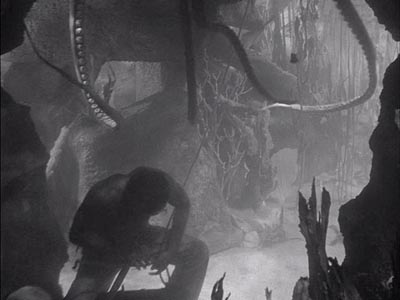
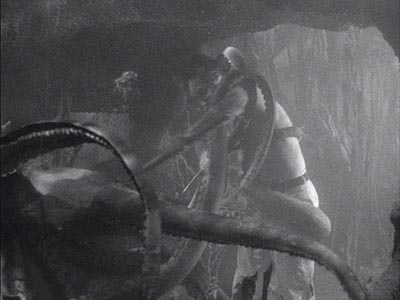
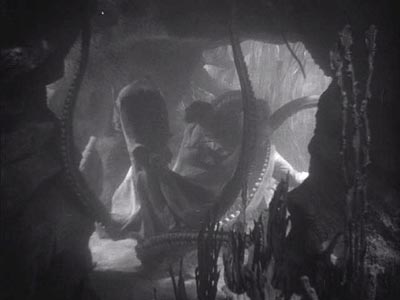
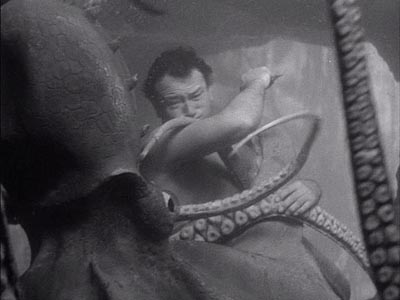
As you might imagine, putting this showstopper in the middle of the film was a bit of a narrative miscue. Frankly, what can you do after a scene like that which isn’t anticlimactic? Admittedly, the end of the picture remains pretty spiffy. This features Ralls, clad in an old-fashioned deep sea diving suit, attempting to retrieve the gold from the hold of the sunken Red Witch, which inconveniently is quite precariously balanced on the edge of a deep water shelf. Even so, it’s hard to equal the kick of the octopus scene.
Wake of the Red Witch is not a great film. In particular, the narrative structure is bizarrely and needlessly convoluted. We don’t necessarily lose track of things, but keeping everything straight requires a lot more effort than was strictly necessary. Even so, it’s a more than competent piece of work, and certainly watchable. I can think of a crapload of Wayne films I’d recommend before this one, but it’s exactly this sort of solid but obscure fare that makes Turner Classic Movies such a treasure.
Then there’s the star. Anyone who thinks Wayne couldn’t act is…well, woefully ignorant or just plain imperceptive, to start with. Wayne starred in as many truly great movies as anyone this side of the great Jimmy Stewart, something no one who couldn’t act could have gotten away with. I mean, seriously: Stagecoach, Red River, The Quiet Man, The Searchers (Wayne’s greatest movie, and ironically made the same year as his worst, The Conqueror), Rio Bravo…and that’s just a partial list. And after you exhaust his great movies, there are many, many more very good ones.
The thing about Wayne was that his talent was extremely deep, but not very broad. By which I mean, he didn’t have overmuch range in the sorts of parts he could pull off. Within his niche, however, he could do amazing work. (Actually, you can say the same thing about Robert DeNiro.) In any case, Wayne here provides further evidence of his very real talents, especially during his blackouts, during which he is genuinely scary. The little smile he assumes prior to beating the living hell out of Loring communicates a lot with just a little, which is what good acting is usually about.
Wayne was at his best playing morally conflicted characters, such as in The Searchers and Red River. Ralls isn’t in that class, but he’s also a character who credibly shifts from committing horrific violence, near rape and grand larceny to selfless, reckless bravery. His assault on the octopus is the prime example of this, as he risks a terrible death and then returns to the water rather than leave the job half-finished.
One of the great joys of old films is that they often offer an array of familiar character actors, and this film doesn’t disappoint. Aside from Gig Young and Jeff Corey, the cast offers Gail Russell, Paul Fix, Dennis Hoey (Inspector Lestrade from the Basil Rathbone Sherlock Holmes series), Erskine Sanford, Grant Withers, Eduard Franz (Dr. Stern in The Thing from Another World and star of 1959’s The Four Skulls of Jonathon Drake) and the aforementioned Henry Daniell (oddly, the villain of The Four Skulls of Jonathon Drake). And hey, somewhere in the background is George Barrows, the guy who played Ro-Man and the Great One in Robot Monster.
Obviously, though, the film’s real claim to fame? GIANT INFLATABLE RUBBER OCTOPUS!!!!

OCTOPUS CONTENT: A solid A-. The ‘pus kills a guy before Wayne gets into the water, establishing its deadliness. It’s big enough to seem really dangerous, even to a dude Wayne’s size, but not so big as to defy belief. The only problem is that given its balloon-like nature, Wayne is not allowed to actually penetrate its ‘skin’ while stabbing at it. Still, it’s great stuff. Otherwise, the fight scene is pretty good, and again, you have to appreciate all the underwater work Wayne clearly did himself.
Bonus OCTOPUS CONTENT points must be awarded for the fact that this was the very octopus that Ed Wood Jr. famously stole from storage for his typically inept cheapie The Bride of the Monster. As portrayed in Tim Burton’s Ed Wood, however, the director was unable to procure the motor that moved the thing. Hence the famous scene—ironically, probably more famous than anything in the big budget John Wayne movie the ‘pus was actually made for—where an ancient, sickly Bela Lugosi stood in a frigid pool while manually wrapping the beast’s inert tentacles around himself, in a woefully failed to simulate being attacked by it.
[Set includes Reap the Wild Wind, Rooster Cogburn, The Hellfighters, The War Wagon and The Spoilers.]THE OCTOPUS CHRONICLES PART 3 TO FOLLOW SOON…
A special Jabootu thanks to Roger Hylton and Shane Thielen, both of who went to the hassle of recording the movies on Turner Classics that night and sending me copies thereof. Thanks, guys!!
